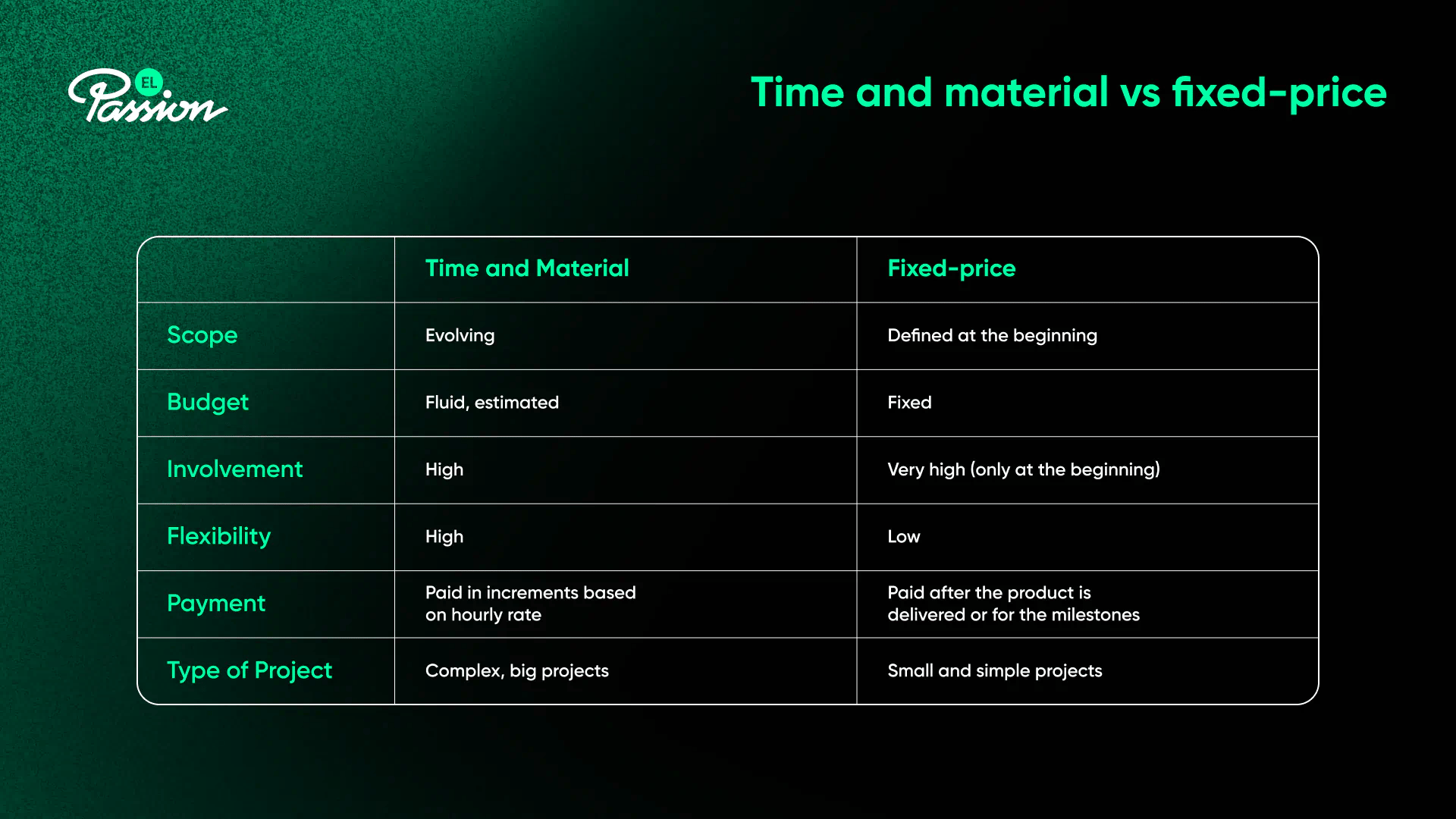19 April 2024 (updated: 19 April 2024)
Time and Material vs Fixed-Price: Which One to Choose for Your Project?
Chapters

Learn about the pros and cons of the two most popular types of contracts in software development services: fixed-price vs time and material.
If you're considering outsourcing the development of your digital product, you've likely come across the two most popular types of contracts: time and material (T&M) vs fixed price. Some might think it's a no-brainer that fixed-price is a better option—you know exactly how much you'll pay and what for. But is that really the case in software development?
The choice of contracting model can have a great impact on the outcomes of a project in terms of cost, risk mitigation, and flexibility. We've prepared a comparison to show that both types of contracts have their pros and cons and are suitable for different project types.
What exactly is the time and material (T&M) contract?
The Time and Material (T&M) contract has become the top choice for most IT projects and rightfully so. The objective is simple—you pay for the actual number of hours spent on the project and the materials used to execute it. The project's scope, or cost, is not fully defined at the beginning but is instead estimated. This means that based on the project requirements, the project manager estimates the time and resources needed to complete the work.
T&M contract is a great choice in dynamic environments where there is the necessity to adjust the scope and resources as the project progresses. This type of contract gives you the possibility to change the scope as the project progresses while ensuring that the other party is reimbursed for the work they have delivered.
T&M contracts require active collaboration and communication between the client and providers regarding the project's status and any changes. This contract type supports agile project management values such as responsiveness to change, iterative approach, and continuous improvement.
Pros of time and material contract
Time and Material (T&M) contract is a great choice for several reasons:
- Quality: Being actively involved with the team allows you to assess the work after each sprint and provide feedback, leading to improved overall quality. Additionally, the agile methodology typically associated with T&M contracts often results in a higher quality final product compared to the traditional waterfall approach due to flexibility and regular testing.
- Flexibility: Changes, a natural part of Agile development, are not a problem with the T&M contract. Constant cooperation between the client and provider allows for ongoing adjustments to the project scope, giving the client greater control over the final product.
- Regular communication: Regular communication means fewer misunderstandings and unpleasant surprises. Communicating regularly with the product team can also lead to more creative solutions to problems.
- Great fit for Agile: As mentioned, T&M contracts support true Agile development. This includes adaptability, close cooperation, and responsiveness to change, making it a great choice for product development.
- Control over budget: Regular assessments after each sprint allow you to modify the scope and team size as necessary. Payments are typically made for the actual work done, often bi-weekly, which gives protection for both parties and helps manage the budget effectively.
Cons of time and material contract
Although most agencies recommend time and material contracts, they have some drawbacks:
- No hard-defined timeframe & budget: This point is directly connected to the Time and Material contract’s flexibility. Since the scope of the project can evolve, you may want to add a few more functionalities along the way. This naturally increases the amount of work needed to complete the project. If you are on a tight budget or deadline, you need to be mindful of the risk of drifting from the original scope.
- High Client Involvement: While it may sound like an advantage, it can be hard, especially for clients who are not experienced in product development. Constant involvement requires not only time but also a commitment to understanding the development process, which can be demanding.
When to choose the time and material contract?
Time and material contract is perfect for:
- Complex and evolving projects: If you're tackling a project that is complex and likely to evolve over time, which could span months or even years, a T&M contract makes it easier to manage these changes.
- Unknown scope and duration: The T&M contract brings the flexibility to make adjustments to the project without the need to renegotiate the entire agreement.
- Agile projects with dynamic requirements: for projects that require adaptability to frequent changes in the industry, a T&M contract supports responsiveness and continuous iteration.
- High engagement and control: If you wish to be highly involved in the project process or need more control over its development, a T&M contract provides more opportunities to stay engaged and make decisions that directly influence the project outcome.
What is the fixed-price contract?
Fixed-price is a contract where the total price and defined scope of work are agreed on before the start of the project. At first glance, this might appear to be an ideal contract type because the budget is set in stone, assuring the client of the exact cost of the project. However, it's important to remember that the scope is also fixed, leaving little room for changes once the contract is signed. The fixed price model is a good fit for projects with well-defined scope and deliverables, as it provides financial clarity.
It is often preferred if the project requirements are clear and unlikely to change, and the client seeks financial stability and predictability. Fixed-price projects also require less client involvement during the duration of the project but require that the client set clear expectations before the project starts. In the fixed price model, the payments are often milestone-based, so no matter how many hours the team has spent to deliver the milestone, you pay the same price.
Pros of fixed-price contract
Fixed-price contract may be the right option for reasons such as:
- Budget certainty: This is one of the most appealing advantages of a Fixed-Price contract. The client knows the exact cost of the project from the start, which is why it is often preferred by clients with limited budgets. It also mitigates the risk of cost escalation.
- Set deadline: If you're on a tight schedule, a Fixed-Price contract may be a better choice. Since the scope is defined and agreed upon at the start, it is less likely that the project deadline will change. This may be a great choice for projects that are time-sensitive or have to be aligned with specific business activities or events.
- Clear deliverables: With a fixed-price contract there are clear and unchanging deliverables since the project scope is set. This brings stability and predictability, that may not always be present in more flexible projects. Thanks to that, both parties have a clear understanding of the deliverables, reducing misunderstandings.
- Less day-to-day involvement: Less Day-to-Day Involvement: The fixed-price model requires less day-to-day involvement from the client, which can be a significant advantage for some. This approach allows clients to change their attention to other business activities, such as the marketing aspects of the project, contributing to the product’s success.
Cons of fixed-price contract
The cons of fixed-price contracts include:
- Lack of flexibility: Imagine you're cooking a meal by strictly following a recipe. Once you start cooking, you cannot adjust the amount of spices or salt. This analogy describes a fixed-price contract where the scope is set in stone, leaving no room for adjustments without drafting a new contract. It brings limitations and may lead to overall worse quality of the project, as there is little room for improvements or changes.
- Less control: Although It may seem like the opposite, a fixed-price contract may give less control over the development of the project. There is less continuous communication, limited opportunities for change, and reduced client involvement. The development team will simply deliver what’s written in the contract, regardless of any new insights or changes that may arise.
- Possible higher cost: Setting the price before the project begins carries numerous risks for the service providers. They must predict all potential costs and risks, which often leads to a higher markup to mitigate these. This can make fixed-price contracts more expensive compared to other contracting methods that allow for more flexibility.
- Longer preparations: Extensive preparations are necessary before developers start the work. The project’s scope and requirements must be thoroughly defined and included in the contract. That’s why fixed-price contracts are usually very extensive with a thorough list of requirements and rigorously defined outcomes.
When to choose a fixed-price contract?
A fixed-price contract is a perfect choice for:
- MVPs - simple projects with limited budget: Fixed-price allows startups to have control over the cost, and also frees up the founders’ time to focus on business activities such as fundraising.
- Small or low complexity projects: These projects typically don’t require many changes throughout the process, making the predictability of fixed-price contracts appealing.
- Website development projects: A fixed-price contract is often preferred for less complex projects where the outcomes are easily defined like in the case of website development, e.g. Webflow development projects.
- Research-based project: Fixed-price contract is a perfect choice for short research projects, such as Product Design Workshop or AI Transformation Workshop. Usually, they are one or two-day-long projects with clear requirements and outcomes.
- Projects with strict budget or timeline: This type of contract ensures the project stays on track in terms of both budget and timeline, providing a clear structure for project completion.
Time and material vs fixed-price: a comparison

The choice between time and material and fixed fee contracts plays a big role in the outcome of the final product. The advantages and disadvantages of each contract type depend on various project factors including scope, timeline, budget, and more.
The choice between time and material and fixed-price contracts depends on the project’s complexity, requirements, need for flexibility, and the level of client engagement. T&M contracts are best suited for evolving, complex projects that benefit from an agile approach, while fixed-price contracts are ideal for simple, straightforward products with strict timelines or budgets.
As an Agile product design and development agency, based on our experience, the time and material contract is often the better choice in most cases, particularly due to its flexibility, adaptability, and, most importantly, the close collaboration it fosters between the client and designers, developers, and Agile project managers.
Check out also:
- How to Choose the Agile Framework for Your Project? - Scrum is not the one & only way to develop software and sometimes it’s not even a good fit for your project.
- Your Digital Product Needs a Product Design Workshop to Scale - A Product Design Workshop helps you strategize, prioritize, and reduce risks in design and development.





